1.e4 c5 2.Nf3 Nc6 3.Bb5 Qb6
I especially like playing solid variations that aren’t quite as popular as “the main lines.” They’re usually just as good, but simply not “in fashion at higher levels.”
Most chess players follow the mainstream of popular thought, which means they’re not as familiar with the secondary lines and ideas behind them. This guarantees I’ll understand the position better than my opponent.
In this particular case, the move 3...Qb6 only appears in my database 137 times in over 8,000 games.
The idea of 3…Qb6 is to prevent White from inflicting damage on my pawn structure after Bxc6, since now I will be able to recapture with the queen.
Battle of Ideas: Bishop Pair vs Pawn Structure
Many openings feature an exchange of bishop for knight when it involves damaging the opponent’s pawn structure. A classic battle of ideas results:
- The side with the bishop pair wants to open the position.
- The side with the knight wants to keep the position closed.
- The side with the knight wants to dissolve his doubled pawns.
4.Bxc6 Qxc6 5.Qe2
Question
Why is 5.Nc3 more accurate?
Answer
Because Nc3 is clearly the best square for the knight. On the other hand, the queen might find a more active square than e2 as the game unfolds.
5...d6 6.h3
White prevents 6…Bg4. He’s playing solid but passive. Many of your opponents will play this way. As you continue to improve, you will focus on clear objectives, and you will win a large number of games through your superior planning and active play.
Question
What is Black’s main objective right now?
Answer
Black wants to make use of the bishop pair. This almost always means opening up the position. Sometimes the right moment appears as a narrow window of opportunity, and you need to make the most of it.
Other times, there’s no hurry, and it’s clear you’ll be able to open the game when the time is right. In that case, spend time preparing the opening of lines so your pieces are well prepared to control key lines and squares when the position opens up.
Question
So how do you “prepare the opening of lines?”
Answer
By understanding the existing or potential pawn levers in the position. Once you’ve identified the levers, then maneuver your pieces into position so they are lead to control the most important lines and squares when the tension is resolved.
Understanding how to create and optimize pawn levers is at the heart and soul of understanding positional chess.
Question
So what’s a “pawn lever?”
Answer
Two pawns diagonally opposed (example: White pawn on d4 vs Black pawn on c5).
Pawns are the soul of chess
– Philidor
6...Nf6 7.d3 g6 8.0–0 Bg7 9.c3 0–0 10.Re1 e5 11.d4 Re8 12.Nbd2 b6 13.dxc5
Question
What’s the best way to recapture?
Answer
The move 13... bxc5 is the best way to recapture for two reasons:
It’s usually best to recapture “towards the center,” especially in the middle game. In the ending you might want to recapture towards the flank, in order to create an “outside passed pawn.” We’ll have an entire lesson on passed pawns in the future.
In this particular case, I intend to play d5 and to open the position for my bishop pair.
How to Find the Best Move
The first reason cited above is a general principle. The second reason is highly specific to the position on the chess board. You’ll win more games as you become increasingly concrete in your thinking. In the meantime, use general principles to guide your thinking, and find the best move.
13...bxc5 14.Nf1?
White doesn’t understand the strategic demands of the position. He should keep the position closed. This will prevent the bishops from playing on a wide open board where their power will be clearly felt.
That means 14.c4 was the right move.
14...d5 15.exd5 Nxd5 16.Ng3 h6
Question
Why did Black play this move?
Answer
Black played this move for several reasons:
- He’s preparing to advance later in the game with
...g5. Remember the bishops want plenty of open space where their long range power comes fully into play. - He’s playing against the knight on
g3. If White playsNe4, then Black will respond with…f5, and he wants to controlg5, so White can’t post his knight on that square. - Black sees variations with White’s queen on
c4, and wants to escape that pressure and consolidate at the same time with...Kh7.
17.Qc2 Kh7 18.Be3?
Be careful of putting your pieces on squares where they can be forked.
18...f5 19.Nf1 e4 20.N3h2 f4 21.Bd2
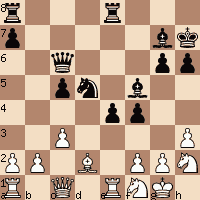
A quick lesson on pawn duos
The pawn duo is defined as two pawns side by side. They are often your best pawn structure for several reasons:
- They control adjacent squares on your opponent’s 3rd or 4th rank. Usually his pieces are unable to occupy those squares, which means their freedom of movement is greatly restricted.
- Both pawns threaten to advance.
- Pieces have great freedom of movement behind the duo, where they position themselves on the ideal squares and prepare to “lever open the position.”
For that reason …
Best Strategy for Playing with a Pawn Duo: Only consider advancing one of the pawns (a) if you’re pressured into making that advance, or (b) you see a concrete way of increasing your advantage.
21...Bf5 22.Qc1 g5 23.a3 c4
Question
Why is 23…c4 so appealing?
Answer
It paralyzes White’s queenside. Black uses a single pawn on c4 to restrain two enemy pawns (c3 and b2). Remember this concept, because it’s very powerful:
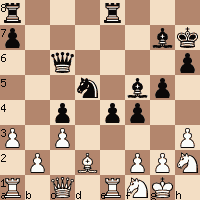
24.Ng4 h5 25.Ngh2 Rab8 26.Qd1 Kg6
White’s options are so limited that I can even use my king to consolidate the pawn structure.
27.Qc1 Rb7 28.Re2 Reb8 29.Ra2
White defends against Black’s threats on the b file. However, in positions with a huge space advantage where the opponent has no counterplay, there is no hurry to “achieve a winning position.”
29...Qb6 30.Be1 g4 31.hxg4 hxg4 32.Rd2 Rd7 33.Kh1
Black threatened g3.
33...Re8 34.Rd1 e3
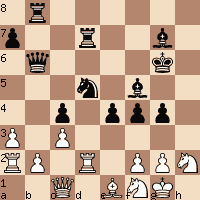
How to Play when You Control the Space
When you control all the space you can operate against the entire board. Many times you won’t be sure where you’ll win the game. Keep maneuvering, look for key weaknesses, make threats all over the board, and eventually your opponent’s position is almost bound to fall apart.
In this game, all the following is happening at once:
- Black has queenside pressure against
b2. - Black threatens to play
g3on the kingside. - Black is breaking through in the center right now.
35.fxe3 Qb3
A strong “in between move.”
Question
What’s an “in between move?”
Answer
An “in between move” appears in the middle of a sequence of captures and recaptures. It’s designed to increase the strength of the immediate tactical operation.
36.Ra1 fxe3
Material is equal, but all of White’s pieces are crowded on his first two ranks, and Black controls the entire board.
37.Bh4 Rh8 38.g3 Be4+ 39.Kg1 e2
Something had to fall before long. It’s amazing that White has lasted for 39 moves without losing material.
40.Qg5+
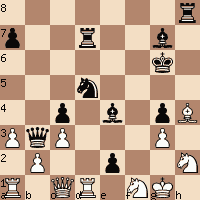
This was an internet blitz chess game, and I missed 40.Qg5+ when I played e2. Even when you have a huge advantage it’s important to monitor your opponent’s possibilities until the very end.
Every move creates a weakness
Not only that, remember that you always surrender control of more than one square each time you move a piece or a pawn. When I advanced the pawn to e2, I opened the line for White’s queen to enter the game, and was fortunate that I didn’t lose material or get mated when that happened.
Understand Backward Momentum
Many times in chess your opponent will gain a temporary initiative when you take time out to capture a piece. This usually happens one of three reasons:
- Sometimes, your piece gets decentralized when you make the capture (perfect example: capturing a rook in the corner with your knight).
- Your opponent is allowed to continue with his plan (often on the other side of the board) when you take time out to make the capture.
- Sometimes you surrender control of an important square (that’s what happened in this game).
When your opponent gains this initiative, you often have to spend time retreating or regrouping your pieces. I call this “backward momentum,” and it’s important to realize it’s a natural part of the game.
The key is to evaluate the strength of your opponent’s initiative, and how it can be first contained and then neutralized. If you’re uncertain it can be neutralized, then often it’s better not to capture the material, continue to increase the pressure, and look for a better opportunity to convert your advantage.
40...Kf7 41.Rxd5 Bxd5 42.Qf5+ Kg8 43.Ne3 Qxb2
Weaknesses are falling like fruit off a tree.
44.Re1 Qd2 45.Qf2 Bxc3
Note the awesome power of the bishop pair. Their strength has continued to increase as the position has opened up.
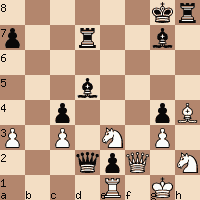
46.Rxe2 Qc1+ 47.Nhf1 Bf3 48.Rc2 Qxa3 49.Nxc4 Qa1 50.Qc5 Bd4+ resigns

Iam relatively new to chess. I am having fun, but having a tough time against Boris in your website. What is the level of Boris (the elo level )?
GOOD
GOOD